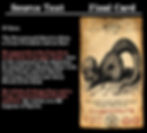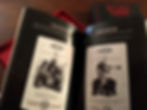The Occult Tarot
- travisdmchenry
- Jan 4, 2021
- 4 min read
Updated: Aug 8, 2021
In 2017, a deck was created called the Demon-Possessed Tarot. This deck captured the essence of every demon of the Goetia and trapped them in the cards. The cards were meant to look like authentic copies from a deck created in the 1600s by a conjurer and then hidden away in the wall of a castle for four hundred years.
This deck felt ancient and mystical--imbued with real magic--making each card truly unique with a life all its own.

In 2018, the Demon-Possessed Tarot was launched on Kickstarter and was a massive success. The deck was quickly licensed by Rockpool Publishing, a mind-body-spirit publisher in Australia. They performed a slight redesign to make the deck more commercial friendly and relaunched it in 2020 as the Occult Tarot. This new version became the #1 New Tarot Deck on Amazon the week it was released and has continued to be a runaway success.
This article will look at the origin of the Occult Tarot and the work that went into creating one of the most intriguing decks to come along in the last 10 years.

In many cases, the artwork representing the demons was easy to find and came from an established artistic and folkloric tradition.
However, pictorial representations of some demons have either never been created or do not accurately match the description of the demon found in the Ars Goetia. To remedy this, I combed through thousands of public domain images from old books to find quality pictures that accurately represented the demons who had never been drawn before. Many of the drawings had extensive amounts of background clutter (mostly mountains and random lines) that are really distracting. I painstakingly erased these lines and also touched up the images where necessary.

Many source texts contributed to the creation of the Occult Tarot.
For example: The system of correspondences between the Tarot and the Goetia was compiled from multiple authors. The descriptions and names of the demons varied slightly between sources; however, whenever there were significant differences, I always used the name in the summoning sigil as the primary name on the card and the alternate name / spelling was included on the lower right hand corner.
Drawings, sigils, quotes about the demon, and obscure astrological symbols were gleaned from half a dozen different ancient texts.
My primary sources in developing the Demon-Possessed Tarot were:
The Testament of Solomon (100 - 300)
Key of Solomon (1300s - 1400s)
The Grand Grimoire (1521)
Pseudomonarchia Daemonum (1577)
Archidoxis magica (1591)
The Lesser Key of Solomon (mid-1600s)
Dictionnaire Infernal (1863)
The Tarot of the Bohemians (1892)
Liber 777 (1909)
The Pictorial Key to the Tarot (1911)
The Symbolism of the Tarot (1913)
The General Book of the Tarot (1928)
The correspondence table showing the relationships between the Tarot, the Golden Dawn, Crowley, and the Goetic demons that was used to create this deck may be downloaded free of charge here: DOWNLOAD PDF

All Tarot decks are endowed with esoteric symbols that convey subtextual information and prevent the uninitiated from misusing the cards.
Some demons are more powerful than others and require special circles, symbols, or incantations to be safely summoned into our realm. Many of these demons can only be conjured inside of the Magical Triangle, or kept at a safe distance through use of a magic ring. These protective devices are printed right on the cards where they are needed. Every symbol on every card serves a purpose.
Additionally, each card contains the name of one of 72 Angels of the Shem HaMephorash written in ancient Aramaic script under the name of the demon. "As above, so below."

Although several authors have created correspondences linking the Goetic demons to the Tarot, this linking is actually quite incidental.
The true links originate in the correspondence between the demons and astrological signs (the decans, specifically). Even this system is not truly original as it was derived from the linking of the decans to the 72 names of God (angels who rule over the various demons). This system of correspondence only works for the minor arcana, and previous authors have created significant “doubling up” of demons to decans, making it impossible to follow perfectly when designing a Tarot deck.
After spending several weeks trying to find ways of aligning the demons to specific cards, it became apparent that I would have to develop an entirely new system of correspondence.
Using the basic decan system and various astrological charts, combined with Crowley's correspondences and details gleaned from close readings of the grimoires, I finally settled on a correspondence that links the significance of each Tarot card with the demon's power or abilities.

The changes from the original design of the deck to the new "mass market" version were small, but noticeable. The original deck looks like pieces of worn paper, while the new version is crisp and clean.

The second edition of the Occult Tarot, which was released in December 2020, has red metallic edges on the cards and some structural improvements to the storage box that holds the cards. If you're interested in acquiring this deck, it can be purchased through most metaphysical booksellers worldwide, though Amazon, or picked up off the shelf at Barnes & Noble.
The deck is currently being translated into French and may have a Spanish edition released in the future!

A note on illegal knockoffs...
Starting in July 2020, a factory in China scanned the cards of the Occult Tarot and began selling them for around $8 per deck. This version is pretty easy to spot because it comes in a cheap tuck box and does not include a physical guidebook with the deck. If you see an Occult Tarot with a QR code on the back and an invitation to scan for a digital PDF guidebook, that's a fake deck! Also, the QR code doesn't actually work.

These illegal copies are being distributed through Alibaba and AliExpress, which means a fair number of well-intentioned online stores are carrying them, unaware they're selling illegal fakes instead of the real thing.
If you find these decks on AliExpress/Alibaba/Wish/Geek or any other cheap China-based website, they're most likely fake copies. If you see them for less than list price ($24-$29), they're probably fakes.
One other thing about the fakes: aside from being crappy quality, the counterfeiters were unable to scan the microprint invocations on the front of the cards. So they left them off. This means some of the cards are missing the protective verses specifically required by the Lesser Key of Solomon.
Best of luck with that.
